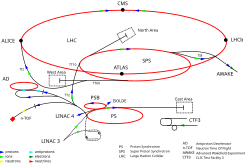CERN Hadron LINACs
 |
|
| List of current particle accelerators at CERN |
|
|---|---|
| Linac2 | Accelerates protons |
| Linac3 | Accelerates ions |
| Linac4 | Accelerates negative hydrogen ions |
| AD | Decelerates antiprotons |
| LHC | Collide protons or lead ions |
| LEIR | Accelerates lead ions |
| PS | Accelerates particles |
| PSB | Accelerates protons |
| SPS | Accelerates protons and lead ions |
The CERN hadron LINACs are linear accelerators that accelerate beams of hadrons from a standstill to be used by the larger circular accelerators at the facility.
LINAC 1 was designed and built during the 1950s to inject 50 MeV protons into the PS. The first beams were accelerated in 1958, and the accelerator was fully operational by 1959. From 1964 until its eventual decommissioning, the LINAC was used to accelerate light ions, such as deuterons, alpha particles, oxygen ions and sulphur ions. After LINAC 2 was built, LINAC 1 was used to deliver ions to the Super Proton Synchrotron. LINAC 1 ceased to be used in experiments in 1992.
LINAC 2 replaced LINAC 1 as CERN's primary source of proton beams in 1978. It kept the same beam energy, but allowed for more intense beams. It injects into the Proton Synchrotron Booster (PSB), rather than directly into the PS, which further accelerates the protons.
LINAC 3 was commissioned in 1994 and is currently used to accelerate lead ions for the PSB, LHC and fixed target experiments at the SPS and LEIR. LINAC 3 is expected to stay in use at least until 2022.
LINAC 4 is a future linear accelerator, designed to replace LINAC 2 in 2020. Unlike its predecessors, LINAC 4 will accelerate negative hydrogen ions to an energy of 160 MeV. The ions are then injected to the PSB where both electrons are then stripped from each of the hydrogen ions and thus only the nucleus containing one proton remains. By using hydrogen ions instead of protons, the beam loss at the injection is reduced and simplified and this also allows more particles to accumulate in the synchrotron. Linac 4 will increase the energy by a factor of three over its predecessor, LINAC 2, and achieve an energy of 160 million electronvolts. This energy increase, when combined with the increased accumulation of particles will enable the beam intensity to double when later delivered to LHC. This is part of the planned luminosity increase of the LHC which is scheduled for 2021.
...
Wikipedia
